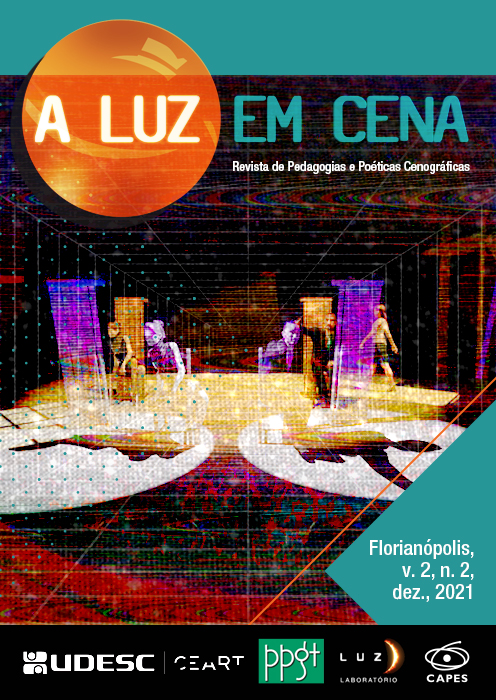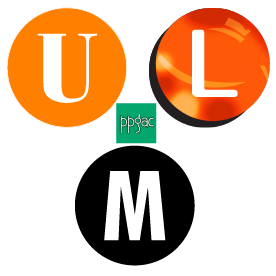Trajes iluminados: un estudio para un espectaculo basado en Hamlet-Maquina
DOI:
https://doi.org/10.5965/27644669020220210205Palabras clave:
luz, teatro, traje de cena, tecnologiaResumen
El objetivo de la presente investigación es analizar trabajos que presentam prendas y bordados textiles hechos com luces para observar cuáles son los principales usos en los espacios teatrales o en cuales otros medios se podría aplicarse la luz. El estudio es parte una investigacion para la dirección de arte de la muestra Hamlet-Maquina (Heiner Muller; 2017) organizado por Teatro Ludos, AdaLab e LA laTA, todos projetos de Universidad Federal de Goiás (Brazil). Fueram hechos ocho encuentros virtuales durante el período de cuarentena (COVID 19) para discutir los textos de Hamlet (Shakespeare) y Hamlet-Maquina (Heiner Muller)pero también para discutir sobre la historia de la moda, identidades y mascaras de teatro. Durante las discusiones decidimos adoptar temas como el transhumanismo y la inviabilidad de desvincularmos de la compleja sistematización de los intercambios digitales en nuestra vida diaria. Nos interesa utilizar prendas y objetos iluminados que se adapten facilmente a la movilidad del cuerpo. Aunque no podemos tener reuniones presenciales para desarrollar más ideas, durante la cuarentena pandémica del covid 19 podemos investigar previamente la relación entre aclaraciones y prendas. Com algunos resultados, observamos que la luz y las prendas suelen presentarse en formas teatrales como un efecto especial (efecto según la justificación de Cibele Forjaz Simões, 2015) o de forma similar a la que se utiliza para trabajar en el teatro de luz negra. También encontramos el uso de la iluminación como parte del método o procedimientos internos que utiliza el artista, bailarín o performer. Nos dimos cuenta de que todavía hay lugares para una luz más presente, que pode hacer visibeles a los actores o el espacio que los rodea, pero también una luz bordada en las prendas que puede contribuir a la visualidad del espetáculo.
Descargas
Citas
BONFANTI, G. Luz no Teatro da Vertigem: processo de criação e pedagogia. In.: Revista Sala Preta. 2015. Disponível em: http://www.revistas.usp.br/salapreta/article/view/102061/107037. Acesso em 10.10.2021, 14h50min.
GAO, Y. (No)Where, (Now)here. 2013. Disponível em: http://yinggao.ca/interactifs/nowhere-nowhere/. Acesso em: 15.12.2021. 13h21min
GLOBE THEATER. Disponível em: https://www.shakespearesglobe.com/. Acesso em: 15.12.2021. 11h05min.
MULLER, H. Hamlet-Máquina. In.: O Teatro de Heiner Muller. Editora Perspectiva: São Paulo .1997
NASCIMENTO, R. Roupas Inteligentes. Editora Senac: São Paulo. 2019
NASCIMENTO, R. Papparazi Lover. 2012. Disponível em: http://www.onascimento.com/paparazzi-lover. Acesso em: 15.12.2021. 16h01min
PANTOUVAKI, S. Embodied interactions: Towards an exploration of the expressive and narrative potential of performance costume through wearable technologies. 2014. Disponível em:https://www.academia.edu/19435055/Embodied_interactions_Towards_an_exploration_of_the_expressive_and_narrative_potential_of_performance_costume_through_wearable_technologies , Acesso em 15.12.2021. 16h16min.
ROSENTHAL, J.; WERTENBACKER, L. The Craft and Career of Jean Rosenthal. Little, Brown and Company: Boston. 1972
SANTAELLA, L.; Pós-Humano Por Que? In: Revista Usp. 2007. Disponível em: https://www.revistas.usp.br/revusp/article/view/13607 . Acesso em 15.12.2021. 16h46min.
SHAKESPEARE, W. Hamlet. Penguin: Londres. 2015
SIMÕES, C. À Luz da Linguagem: um olhar histórico sobre as funções da iluminação cênica.
In: Sala Preta. 2015. Disponível em: https://www.revistas.usp.br/salapreta/article/view/105752. Acesso em 10.10.2021. 13h02min
SIMÕES, C. A Eletricidade entra em Cena. Revista Urdimento. 2018. Disponível em: http://www.revistas.udesc.br/index.php/urdimento/article/view/141457310131 018063. 10.10.2021. 13h02min
WILSON, R. Hamletmachine. 1997. Disponível em: https://robertwilson.com/hamletmachine. Acesso em: 15.12.2021. 11h020min.
Descargas
Publicado
Cómo citar
Número
Sección
Licencia
Derechos de autor 2021 Rafaela Blanch Pires

Esta obra está bajo una licencia internacional Creative Commons Atribución 4.0.



